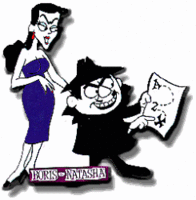From the "Stop, Thief!" files and Yahoo! News...
 Sudiegirl sez: I'm including this lovely image of Boris and Natasha to show that sometimes, all these claims of corporate skullduggery play out like an episode of "Rocky and Bullwinkle". I mean, they're TV dinners, for GOD's sake! They're so high in sodium they'd choke a horse, and nobody has answered my question as to whether or not your tongue will stick to a TV dinner if you lick it. So on that oh-so-dignified image, let's start the show, OK?
Sudiegirl sez: I'm including this lovely image of Boris and Natasha to show that sometimes, all these claims of corporate skullduggery play out like an episode of "Rocky and Bullwinkle". I mean, they're TV dinners, for GOD's sake! They're so high in sodium they'd choke a horse, and nobody has answered my question as to whether or not your tongue will stick to a TV dinner if you lick it. So on that oh-so-dignified image, let's start the show, OK?Obit Sparks Debate Over TV Dinner Creator
By MICHELLE ROBERTS
20 minutes ago
PHOENIX - This much is certain: When C.A. Swanson & Sons began selling a frozen turkey dinner with peas and sweet potatoes, the housewives of baby boom America snapped them up, and the TV Dinner, with its three-compartment aluminum tray, soon became a symbol of postwar consumer society. (Not to mention lonely nights watching "Wheel of Fortune" and realizing that your peas are still frozen in the middle. Eeewww...)
So when Gerry Thomas, the Paradise Valley retiree often credited with inventing the TV Dinner, died last month, it was widely reported as the passing of the man behind a piece of 20th century Americana. (Has anyone found out the whole coffin scenario yet? Is it divided into three pieces?)
Since then, though, questions have been raised about whether the 83-year-old former Swanson salesman and marketing executive — and member of the Frozen Food Industry Hall of Fame — got too much credit. (Doesn't it seem like "Dragnet" music should be playing here? I wish I knew how to insert audio clips...)
Pinnacle Foods Corp., the company that now sells Swanson-brand frozen foods, considers Thomas the man who developed the concept of the TV Dinner, a frozen meal marketed in a box made to look like the front of a television set at a time when TVs were going from novelty to household appliance. (Fair enough...)
The Swanson frozen foods business has gone through several owners since the creation of the TV Dinner — Pinnacle Foods acquired the brand in 2001 — but the story of Thomas' involvement is the one that has been passed down from one corporate generation to another.
"We don't have any reason to disbelieve that history," said Kelley Maggs, a spokesman for the New Jersey-based company. (Also understandable...)
On Sunday, the Los Angeles Times published an editorial calling Thomas "a charlatan." The editorial was based on a 2003 article in which Swanson heirs and a Swanson employee of the era denied Thomas was the inventor of the TV Dinner. (Again, "charlatan" seems pretty harsh, don't you think? Come on...it's the language of hate.)
Betty Cronin, a 76-year-old former bacteriologist and product developer for Swanson, said she does not believe Thomas deserves credit for inventing the TV Dinner. (Yes, but does she believe in Tom Cruise? The AMA doesn't, and neither do I. How about the Tooth Fairy, or the Easter Bunny?)
She helped developed the company's fried chicken dinner and knew Thomas, then a salesman for Swanson. She said from her New Jersey home Wednesday that she does not understand how he came to be touted as the creator of the TV Dinner. (Maybe she didn't get the memo?)
Cronin said that Clarke Swanson, one of the brothers who ran company, worked on the tray design, and that many people in sales and marketing were called together to figure out how the oven-ready meals would be sold. (Yeah, but just because one person worked on the tray design doesn't mean another person did say, "Ya know, how about a three-section tray? How would that work?" I mean, Thomas was a marketing guy, not an engineer. He probably couldn't draw, and someone else could! What does that prove? And isn't it customary that multiple people from sales and marketing would be drawn into a project like this? She needs to get a grip. It takes many people to bring an idea to fruition, but only one to come up with the concept in the first place.)
Thomas himself claimed he came up with the idea for the three-compartment tray, coined the "TV Dinner" name and developed the packaging that helped sell the dinners to a country fascinated by the new medium of television. (Read above...he probably came up with the ideas and all, but many people brought them to fruition. I love that word, BTW!)
Thomas' wife, Susan, said in an interview shortly after Thomas' death July 18 that his contribution to the TV Dinner was the marketing. "If he was an inventor of anything, it was an inventor of slogans or names," she said. (OK, the wife doesn't believe? Hmmm)
Frozen dinners existed before Swanson began selling them in 1954. (Well, that would make sense, if people had freezers, you know?)
Maxson Food Systems Inc. was selling frozen three-part meals for airplane passengers in 1945, according to Library of Congress researchers. Some smaller companies were selling frozen dinners on aluminum trays in the early 1950s, but it was not until Swanson's TV Dinner hit supermarket shelves that tens of millions of the tray dinners were served up in American living rooms. (But remarkably enough, they still all taste the same!)
Robert Thompson, a Syracuse University professor and authority on television and American pop culture, said that until last year, Thomas had spent one day each summer talking to graduate students in Thompson's history-of-television class. (That would have been interesting to sit in on, don't you think?)
Thompson said that corporate histories can be difficult to verify, and sometimes, particular individuals are selected as frontmen for innovations. (That makes sense, too.)
"When you're talking about a corporate invention, the question of authorship is so much more complex," he said. (Yep, and nobody wants to be left holding the bag.)
___
On the Net:
Library of Congress page on TV Dinners: http://www.loc.gov/rr/scitech/mysteries/tvdinner.html
Swanson Foods: http://www.swansonmeals.com/webportals/
Sudiegirl's final word?
No matter who invented them, they still taste like cardboard (except the chicken-fried steak ones that Banquet makes).
And just a reminder from the "Idea Cop" shown below...give credit where it's due. You'll be glad you did...and thanks to Michelle Roberts for a great feature story!













 /div>
/div>






|